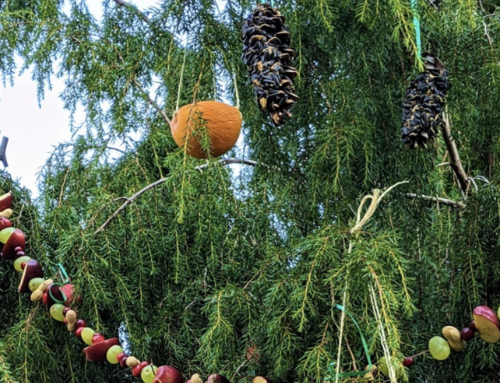Of all the holiday traditions, decorating with holly branches is probably the oldest. It all starts with the ancient Romans as they would dress their homes with holly during the celebration of Saturnalia which was observed in December before the winter solstice. Actually, it was a good idea to have hollies around all year long — thought ancient people.
Pliny the Elder (AD 23-70), a Roman naturalist, tells us that holly planted near a house or farm would defend it from witches and lightning. Romans also thought that the holly flower would cause water to freeze and that wood from holly, thrown at an animal, would make the animal return and lie down. Wow, that would be handy.

Hollies had significance beyond Ancient Rome and in the time after the fall of Rome. The Druids and Celts believed that hollies were a symbol of eternal life because they stayed green though the winter. They, too, brought holly branches into their homes for protection from witches and lightning strikes. Interestingly, modern scientists have discovered that the spines on holly leaves can act as little lightning conductors, thereby protecting the tree and other nearby objects, lending some credence to this folk belief. Leaves brought inside were said to encourage fairies to enter and bring good luck. Cutting down a holly, however, caused bad luck. Wood from the holly made exceptionally good wands which could be used to banish unwanted entities. Harry Potter could attest to this as his wand is made of holly. Hollies were also prescribed for treatment of illnesses — curing everything from bronchitis, fever, influenza, whooping cough and rheumatism.
As Christianity spread across Europe, the use of holly decorations was incorporated into the celebration of Christmas. In Christianity, the prickly holly leaves represented the crown of thorns and the red berries symbolized Christ’s blood. Early Christmas trees in England were holly trees, not fir trees. A sprig of holly was often used to decorate the traditional English Christmas dessert – plum pudding.

When European settlers began arriving on the Eastern seaboard, they were pleased to find holly growing throughout the area. But this holly was different from the European holly (Ilex aquifolium) they were familiar with. This holly was American holly (Ilex opaca). There are a few subtle differences. Both have dark green leaves, but the English holly leaves tend to curl under, tucking in the spines. The American holly leaves are flatter, and the spines stick straight out. There are 480 species of holly found throughout subtropical and temperate areas of the world, a genus that includes trees, shrubs and vines. They can be deciduous or evergreen and the berries may be red, white, yellow, black or pink. The common winterberry (Ilex verticillata) is a type of deciduous holly.
Autumn is a wonderful time to look at hollies. As the maples and oaks lose their leaves, the hollies stand out in the landscape. The berries shine brightly among the boughs. After a few frosts, the berries become more attractive to wildlife. Having a holly nearby can make for great early winter bird watching.

Based on the Painter Brother’s plant catalogues, we know that there have been hollies at Tyler since at least the 1850s. At the present time, the Arboretum has a collection of 142 different types of hollies and over 550 individual holly trees scattered throughout the property. There are hollies with a variety of leaf shapes and red, yellow or orange berries. There is a particularly large collection of hollies near the maintenance building. Next time you visit Tyler be sure to check out some of these beautiful specimens maintained by the Arboretum. How many different types can you spot?
If you are thinking of adding one of these wonderful plants to your garden, there are a few things to consider. Holly flowers are dioecious, meaning individual plants have either male or female flowers. For the female flowers to produce berries, they must be pollinated by bees or other insects with pollen from the male flowers. For this reason, male and female hollies are often planted together.
You should also choose the right holly for your garden. Hollies have tremendous range. The American Holly (Ilex opaca), is evergreen and can grow up to 30’ tall, making it a wonderful screen for your property line. On the other hand, dwarf cultivars of winterberry holly (Ilex verticillata) such as ‘Red Sprite’ only reach about 3’ in height and are deciduous, showing off their brilliant red berries when the leaves drop in late autumn.

In general, hollies are easy to grow, respond well to pruning and are beneficial to pollinators and birds. Many types of birds enjoy the berries, and the thick cover and prickly leaves provide a safe place to hide from predators. No matter what holly you plant, you’ll be benefiting your local wildlife. And who knows…you might also find yourself with fewer visiting witches.






